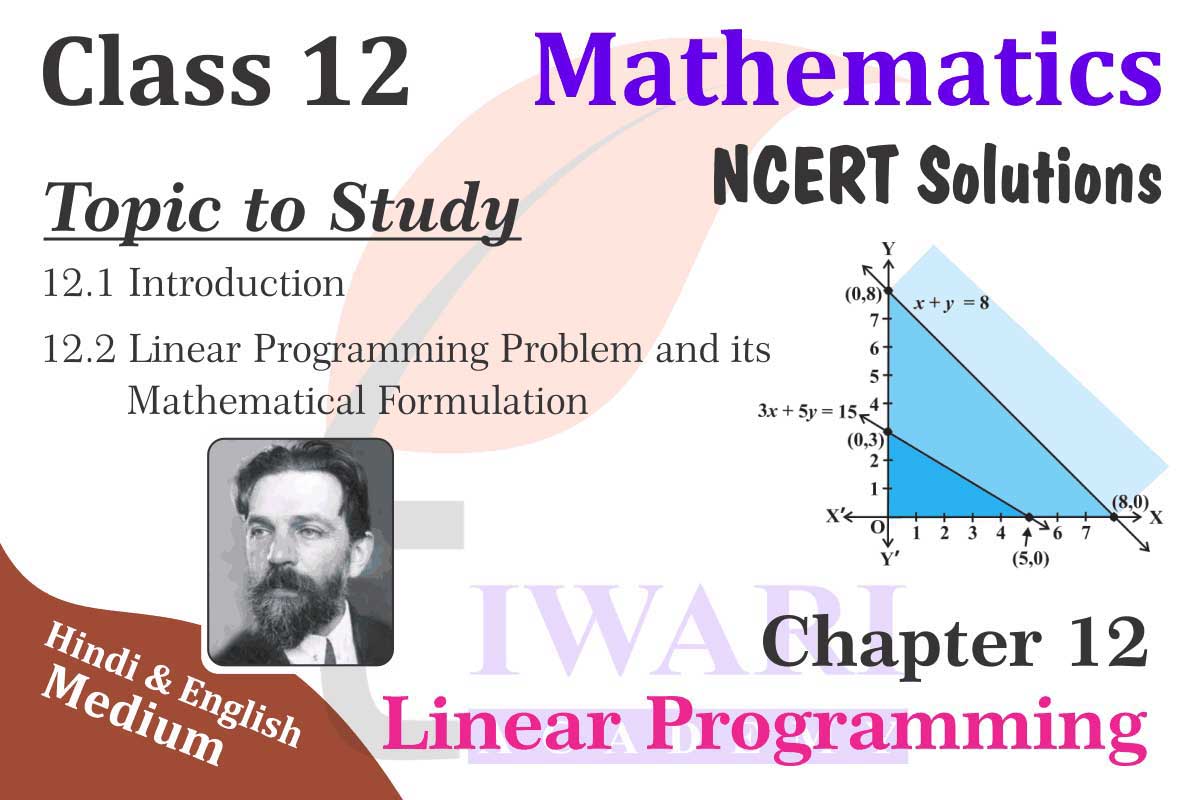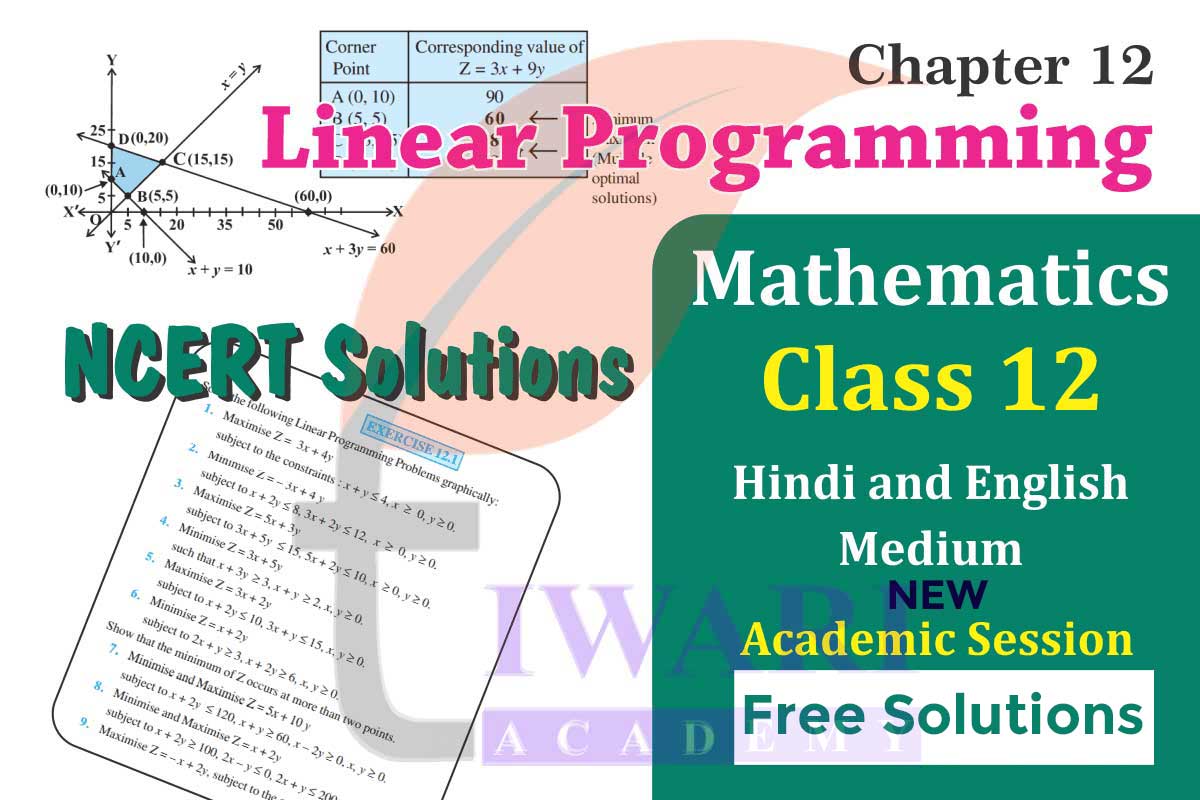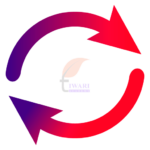NCERT Textbook Solutions for Class 12 Mathematics Chapter 12 Linear Programming (LPP) in Hindi and English Medium updated for 2025-26 Maths exams. NCERT Textbook Solutions for Class 12 Mathematics Chapter 12 Linear Programming, an important part of Class 12 NCERT Maths, involves solving optimization problems with constraints. NCERT Exercise Solutions for Chapter 12 Math provide a step-by-step guide to tackle problems in a structured way. NCERT Class 12th Mathematics solutions are designed to help students understand complex problems and how to represent them graphically. With resources like PDF downloads and online videos, these solutions simplify concepts like constraints, feasible regions and objective functions.
NCERT Textbook Solutions Class 12 Maths Chapter 12 Linear Programming
Whether solving exercise 12.1 or miscellaneous questions, NCERT PDF solutions offer clarity on the process of maximizing or minimizing values, an essential mathematical skill. Free PDF solutions for NCERT Math Chapter 12 are widely available online, ensuring students can practice solving NCERT based problems anytime. These NCERT Textbook Maths solutions also provide a detailed approach to graphing equations and identifying the feasible region, making Linear Programming less intimidating for Class 12 math students. As per the new NCERT textbook, there is only one exercise in Chapter 12 Class 12th Maths.
Class 12 Maths Chapter 12 Solutions in English and Hindi Medium
Solving Math Problems with Class 12 Mathematics Linear Programming NCERT Book Solutions
Class 12 Mathematics NCERT Textbook Chapter 12 introduces various types of Mathematical Linear Programming problems, such as transportation and diet problems. NCERT Detailed Solutions provide detailed explanations for exercises like 12.1 and 12.2, ensuring students master both theory and application. Using NCERT Brief solutions, students can graphically solve problems to find the feasible region and optimal points. Resources like Hindi Medium and online videos make these NCERT mathematics solutions accessible to all students.
Whether practicing important questions or solving solved examples, the solutions guide students to represent constraints graphically and calculate the objective function effectively. Free PDF downloads of NCERT Complete solutions enable students to practice at their own pace. By following the structured steps in NCERT Solutions, students not only prepare for exams but also gain mathematical confidence in solving Linear Programming problems through real-life examples.
| Class: 12 | Mathematics |
| Chapter: 12 | Linear Programming Problems |
| Number of Exercises: | 1 |
| Content: | Exercises and Extra Questions |
| Content Mode: | Text, PDF and Online Videos |
| Session: | CBSE 2025-26 |
| Medium: | Hindi and English Medium |
Benefits of NCERT Mathematics Textbook Solutions for Class 12 Maths Chapter 12
NCERT Math Solutions for Class 12 Mathematics Chapter 12 Linear Programming are invaluable for students preparing for board exams. NCERT Class 12th Mathematics Book solutions, available as free PDF downloads, include graph-based explanations for complex problems, helping students visualize and solve efficiently. Detailed explanations for exercises 12.1 and miscellaneous problems ensure a comprehensive understanding of the chapter. Hindi versions or Hindi Medium and step-by-step videos make these resources accessible to students from diverse backgrounds.
Whether downloading online resources or studying with a printed PDF, NCERT solutions fulfill varied learning needs. Important questions and solved examples from Chapter 12 are explained in an easy-to-follow format, reducing the difficulty level of Linear Programming. By practicing these mathematics book solutions, students can confidently handle constraints, feasible regions and optimization problems while boosting their exam scores and problem-solving skills.

Important Points for Class 12 Maths Chapter 12 Linear Programming
1. Understand the concepts of constraints, feasible region and objective function.
2. Practice graphically solving Linear Programming problems from exercises 12.1.
3. Focus on solving transportation and diet problems.
4. Revise important questions and solved examples for exams.
5. Master graphical representation techniques for accuracy.
| Day | Topics | Activities | Resources |
|---|---|---|---|
| Day 1 | Introduction to Linear Programming | Read the theory and solve solved examples | NCERT textbook, PDF solutions |
| Day 2 | Constraints and Feasible Region | Practice Exercise 12.1 | NCERT textbook, online videos |
| Day 3 | Objective Functions | Solve questions with graphs | Solved examples, free PDF |
| Day 4 | Transportation Problems | Practice Exercise 12.2 | NCERT textbook, video tutorials |
| Day 5 | Diet Problems and Miscellaneous | Solve miscellaneous questions | NCERT solutions, Hindi PDF |
| Day 6 | Revision and Important Questions | Review solved examples and graphs | Online videos, free PDF |
NCERT Solutions for Class 12 Maths Chapter 12
Class XII Mathematics chapter 12 Exercise 12.1 in Hindi and English free PDF format to download updated for new academic session. Class 12 NCERT Text books and their solutions, CBSE syllabus for current year, previous year board papers for practice and assignments, tests, revision books all in PDF. Share your views through Discussion Forum.
Important Questions on 12th Maths Chapter 12
What is an Optimisation Problem in LPP?
A problem which seeks to maximise or minimise a function is called an optimisation problem.
What do you understand by LPP?
A linear programming problem (LPP) deals with the optimisation (maximisation/minimisation) of a linear function of two variables (say x and y) known as objective function subject to the conditions that the variables are non-negative and satisfy a set of linear inequalities (called linear constraints).
What is a linear objective function in LPP?
Linear function Z = ax + by, where a and b are constants, which has to be maximised or minimised is called a linear objective function.
What are decision variables in LPP?
In the objective function Z = ax + by, x and y are called decision variables.
What do you mean by constraints in LPP?
The linear inequalities or restrictions on the variables of an LPP are called constraints. The conditions x ≥ 0, y ≥ 0 are called non-negative constraints.
12th Maths Chapter 12 Solutions
NCERT Solutions for Class 12 Maths Chapter 12 in PDF and Video format to free download in Hindi and English Medium updated for new academic year 2025-26. Download here Class 12 Maths Offline App in English or Class 12 Maths Offline in Hindi Medium free.

1. One kind of cake requires 200 g of flour and 25 g of fat, and another kind of cake requires 100 g of flour and 50 g of fat. Find the maximum number of cakes which can be made from 5 kg of flour and 1 kg of fat assuming that there is no shortage of the other ingredients used in making the cakes. Make an L.P.P. of the above and solve it graphically. [Delhi 2015C]
2. Find graphically, the maximum value of z = 2x + 5y, subject to constraints given below:
2x + 4y ≤ 8
3x + y ≤ 6
x + y ≤ 4
x ≥ 0, y ≥ 0 [ Delhi 2015]
Questions from Board Papers
1. Solve the following L.P.P. graphically:
Minimise Z = 5x + 10y, Subject to constraints x + 2y < 120, x – 2y > 60, x – 2y > 0 and x, y >0. [Delhi 2017]
2. If a 20 year old girl drives her car at 25 km/h, she has to spend ₹ 4/km on petrol. If she drives her car at 40 km/h, the petrol cost increases to ₹ 5/km. She has ₹ 200 to spend on petrol and wishes to find the maximum distance she can travel within one hour. Express the above problem as a Linear Programming Problem. Write any one value reflected in the problem. [CBSE Sample Paper 2017]
3. A manufacturer produces two products A and B. Both the products are processed on two different machines. The available capacity of first machine is 12 hours and that of second machine is 9 hours per day. Each unit of product A requires 3 hours on both machines and each unit of product B requires 2 hours on first machine and 1 hour on second machine. Each unit of product A is sold at ₹ 7 profit and that of B at a profit of ₹4. Find the production level per day for maximum profit graphically. [Delhi 2016]
What are NCERT Solutions for Class 12 Maths Chapter 12 Linear Programming?
NCERT PDF Solutions for Class 12 Maths Chapter 12 Linear Programming are a comprehensive set of resources that help students solve optimization problems involving constraints. These solutions cover all exercises, such as 12.1 and 12.2 and provide step-by-step explanations for solving problems graphically. With the help of free PDF downloads and online videos, students can understand key concepts like feasible regions, objective functions and constraints. The solutions are also available in Hindi, making them accessible to a wider audience. By practicing with these NCERT solutions, students can gain mathematical confidence and perform well in their Class 12 board exams.
How can NCERT Solutions for Chapter 12 Linear Programming help in exam preparation?
NCERT Solutions for Chapter 12 Linear Programming play a significant role in preparing for Class 12 board exams. These solutions provide detailed guidance for solving important questions and miscellaneous exercises using graphical methods. Whether it’s understanding constraints, calculating the feasible region, or maximizing and minimizing the objective function, these solutions simplify the process. Free PDF downloads and online videos make it easy to study anytime. By practicing NCERT solutions for exercises like 12.1 and 12.2, students develop problem-solving skills and improve their accuracy. These resources ensure that students are well-prepared to handle all types of Linear Programming questions in exams.
Where can I find NCERT Solutions for Class 12 Maths Chapter 12?
Students can find NCERT Solutions for Class 12 Maths Chapter 12 Linear Programming online as free PDF downloads. These solutions are available on multiple educational platforms, providing detailed explanations for exercises such as 12.1 and miscellaneous problems. Students can access video tutorials and step-by-step guidance in both English and Hindi. These solutions include solved examples and important questions, helping students master the concepts of Linear Programming, such as constraints, feasible regions and objective functions. With resources like online videos and free PDFs, students can conveniently study and practice at their own pace for better exam preparation.


